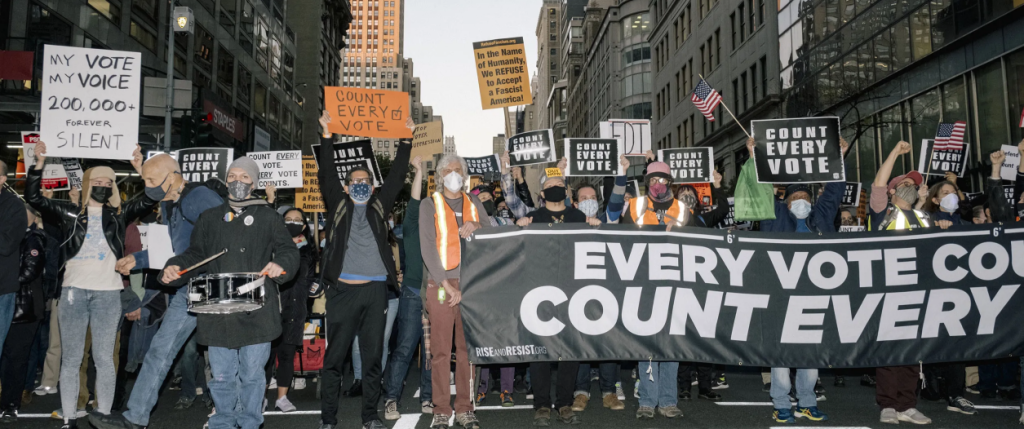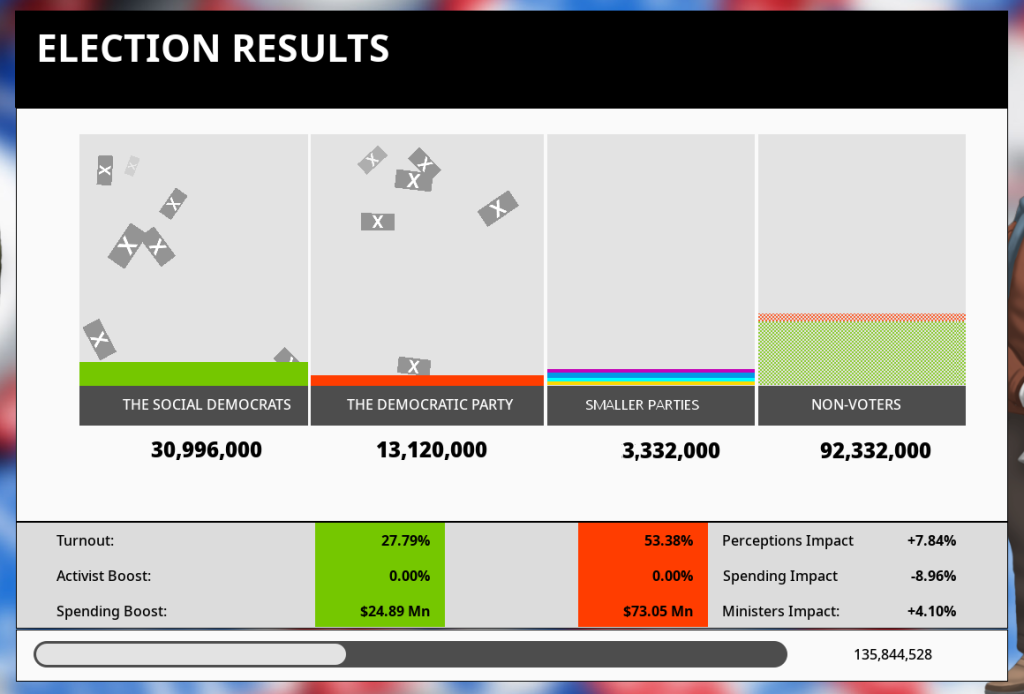Democracy 4 is a game, but its also my attempt at a fairly accurate political simulator, given the limitations that are to be expected when you do not delve into the individual mechanics of voting systems, and constituencies and different systems such as primaries, mid terms etc.
One of the things that may feel unrealistic to you if you play the game and get good at it, is that sometimes you will win with a laughably high share of the vote. 80%, maybe 85% maybe even higher. In the real world, in true trustworthy and secure democracies, this is super rare. Why is this? and how can I fix it in Democracy 4?
The most obvious answer is probably that ‘differing views on politics exist…duh!’ meaning that no party is ever going to win over everybody. This is obviously true, but there is definitely a phenomena where political debate shifts focus over time, and either takes the electorate with it, or is dragged BY the electorate towards it, depending on your POV. This is often called the ‘overton window‘ and is the space in a theoretical political compass that contains the ‘theoretically electable possibilities’.
For example right now in the USA, segregation of the races is most definitely not inside the overton window. No serious party would suggest setting up apartheid in the US. Similarly, the forced seizure of wealthy peoples second homes by the state is not considered. This is also clearly outside the overton window. But there are policies that move in and out of that window over time. Is socialized medicine now in the US window? perhaps obamacare suggests it is, but thats a fairly recent inclusion.

The point I am making is that mainstream political opinion can shift over time, so in theory, if a government does a really good job, it could shift a LOT of people towards supporting it. There may remain 5% hardcore racists and 5% hardcore communist, but its *feasible* that a centrist party could get 90% of the vote, based on policies.
So why does this not happen, ever, and why does it feel weird if it happens in Democracy 4?
The trouble with letting a computer programmer like me design a voting simulation is that we act like classical economists, who have a concept of a rational consumer. Rational consumers have a price at which they buy product A. If the price is too high, we don’t buy, if its low, we buy. Thats classical economics. The problem is, it turns out that classical economics is horseshit.
Read up on ‘behavioral economics’ and you will find its a crazy world out there. It turns out that ‘free’ is a magical price that behaves totally different from $0.01. It turns out that sometimes we will buy more if the price goes up. Sometimes we will value a product at a higher price than we paid for it…for no reason at all other than psychological feelings of ownership. It turns out that we get confused between $2.99 and $3.01 and think the first price is WAY cheaper. If we buy a product for $9,500 and we see an option to add biscuits worth $5 to the price as an add on, we happily pay $20 for the biscuits. In other words, we are dumb, irrational chimps!
The same is true of voting. We do not look at all of the impacts of the various policies proposed by the various manifestos and then make a rational choice. We vote for dumb reasons, in dumb ways, for animalistic and pyschological and completely irrational reasons.
Democracy 4 models some of this as best as it can. Voters are individuals that have a sense of elasticity of opinion, based on age. In other words old people stick to their views and loyalties, young people chop and change. Actual chance of voting depends partly on party membership, partly on strength of feeling, partly on the campaign effectiveness by the likely party we normally vote for, partly on their innate tendency to do things like vote (randomized at birth).
Once a voter actually votes, we base their choice partly on rational policy evaluation, partly on their perceptions of the leader (strong/compassionate/trustworthy?), partly on how fed up with the ruling party they are due to its time in office (inverse political honeymoon), partly on the appeal of the ruling party’s ministers, and the amount that party spends. And a lot of this is mitigated based on how educated the voters are. Poorly-educated are more manipulated by this, and less by policy.
And ultimately this super-complex bunch of code spits out a decision by each voter… and sometimes 90% vote for you.

I just today realized what I’m missing. Tactical voting and protest voting. Basically people actually supporting you, but voting for someone else.
This is a big thing, especially in ‘safe seats’ or ‘non-swing states’ for US readers. If you live in a state where the democrats get 75% of the vote every election, and you are hard left…why vote for the democrats? You can safely vote for a third party harder-left candidate safe in the knowledge that the message will be received…but there is no risk of you letting a republican in. And the same vice versa.
LOTS of people clearly do this… but the game does not yet handle it. Not only that but the *chance* of someone voting is probably also influenced by this. I know 100% that where I live, our next MP will be the same Tory MP we have had here for decades. Its a super safe conservative party stronghold. So in theory, if I was a natural Tory voter, I could safely ‘use’ my vote to send a message to him that he should not be complacent…OR I could just stay at home that day, safe in the knowledge that he doesn’t need my vote and will win anyway.
I need to include this in Democracy 4, and I am just working out a way. Clearly some people are likely to vote tactically and some are not. I could simply give it a percentage and say 10% of the electorate are susceptible to these thought processes, then assign some other thresholds. For example if the polls show >70% approval for the ruling party, then scale in a chance I don’t bother to vote if I support them anyway, or scale in a chance I vote for the closest party to the ruling party that is *not* them (could be one of two opposition parties…).
I need to code this, and test it, but also hopefully find a way to represent this in the game. One way might be to make up a bunch of small protest-vote parties with fringe views, and represent them as another column of ‘smaller parties’ on election day. This could effectively be the ‘protest vote’ column… Still thinking about it, but I think it does need to go in…
 Could this work?
Could this work?